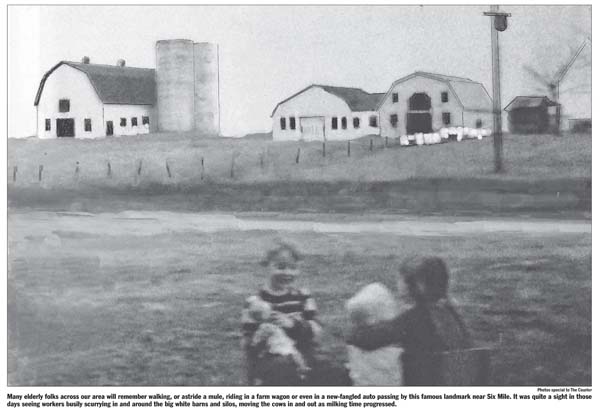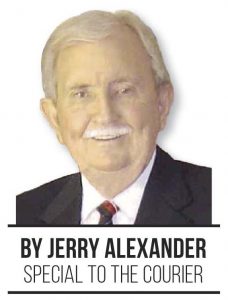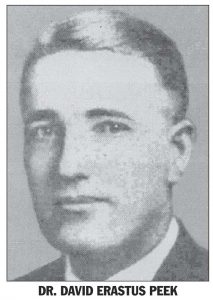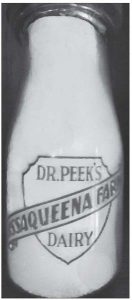Getting a glimpse of History

Rare photograph of Dr. Peek’s Issaqueena Farms Dairy surfaces
Yes, today, we have a very special treat for our readers across Pickens County, especially for our senior citizens. For the first time in many decades, we all can once again feast our eyes on one of the more famous and progressive early businesses from the 1920s into the early 1940s in the Six Mile area — Dr. David Erastus Peek’s Issaqueena Farms milk dairy. It has been gone 70 years.
[cointent_lockedcontent] The photo was provided to Dr. Peek’s son, Barry Peek, by a relative, Harriet Peek Harvey. Mrs. Harvey is a daughter of Charlie Peek, a twin to Harley Peek, both of whom were the youngest brothers of Dr. Peek.
The photo was provided to Dr. Peek’s son, Barry Peek, by a relative, Harriet Peek Harvey. Mrs. Harvey is a daughter of Charlie Peek, a twin to Harley Peek, both of whom were the youngest brothers of Dr. Peek.
This is indeed a rare snapshot taken by Harriet’s mother of youngsters playing in their yard directly across the highway from the dairy complex. The background of that photo just by pure happenstance captured forever a good portion of Issaqueena Farms Dairy. We would even suggest our readers cut out and keep this story for its important historical value, if you wish.

DR. DAVID ERASTUS PEEK
The dairy was started in the 1920s by beloved Six Mile physician Dr. David Erastus Peek, a native of the Pine Creek community of Jackson County up in western North Carolina. Having headed an extremely successful medical practice here from the 1920s into the 1940s, his new dairy was so innovative that it became the first in South Carolina to pasteurize milk and the first in the southeastern United States to add vitamin D to milk, according to his son, Barry.
The facility, located about a half-mile south of Six Mile on the Norris Road, provided fresh milk in glass bottles for hundreds of families within a large radius. Issaqueena Farms Dairy products were distributed to many towns and mill villages across Pickens County and in the city of Greenville until the early 1940s. One source recalled milk was even

Collectors seek them today, and it is indeed a rarity to find one of these glass bottles emblazoned with DR. PEEK’S ISSAQUEENA FARMS DAIRY across its middle. Full of fresh, tasty pasteurized milk through the 1920s, 1930s and into the early 1940s, they graced hundreds of rural and city dinner tables. This half-pint bottle was given to author Jerry Alexander many years ago by Mrs. David Peek of Pickens, daughter-in-law of the late physician and dairy owner. Luckily, an occasional bottle sometimes may still be found in area antique shops across Pickens County.
delivered to local CCC work camps for meals served to workers constructing Oconee State Park, Table Rock State Park and at nearby Issaqueena Lake Park during those years. Issaqueena Farms milk was also enjoyed by youngsters at Shriner’s Hospital, it is believed.
Dr. Peek’s parents, Montgomery “Gum” and Harriet Moss Peek, had migrated here in 1915, from their mountainous Jackson County, N.C., home. Gum wanted to get his family out of the cold mountain weather there and to try his hand at growing cotton for a living, which they did.
The couple and their children arrived in Six Mile after two days of laboriously traveling rough, crooked muddy roads snaking through the mountains in two covered wagons, according to Six Mile native, the late Dr. Virgil Mitchell. Dr. Mitchell’s sister became the wife of Charlie Peek. Virgil himself said he worked as a boy alongside his kinfolk, helping with the building of the roof on the dairy barns.
Dr. David Peek and his new wife, Florence Wike Peek, came to Six Mile in 1918 following his graduation from Emory Medical University in Atlanta. He quickly began his practice, and over the years built it into one of the best-known medical ventures in Upstate S.C.
This was in an era when slippery mud was about the only constant road surface in bad weather. With only one mile of paved road existing in Pickens County, he successfully — most of the time — made it out to scattered rural homes where he was needed. Dr. Peek had traded a fine Tennessee walking horse for a model T Ford. The horse was a blue-ribbon winner in the Jackson County, N.C., Fair. The solid Model T repeatedly carried the young physician over almost impassable terrain when soaked with torrential rains. However on occasion, he had to call on a farmer for a horse, mule or oxen to pull him out of and across deep mud holes along his journeys. Traveling these roads was time-consuming for the very busy doctor.
In fact, Barry recalls his mother, Florence, relating a story many years ago about it taking her some three days to travel back to her former home in Cullowhee, N.C., on her first trip after settling here in Six Mile.
“She said it took her three days, beginning the trip in a covered wagon from Six Mile up to the area of Lower Whitewater Falls, where they camped for the night,” Barry said. “The second day they proceeded on to the area of Glenville, N.C., where she spent the night with a cousin. The third day, she rode with her cousin’s husband, a Jackson County rural mail carrier, in his car to her Cullowhee destination. Now I can probably drive there in an hour and a half.”
Dr. David and Mrs. Florence Wike Peek were the parents of four children: David, Frances, Robert and Barry. Frances, Robert and Barry are their surviving children. Robert and Barry contributed to this article.
The barn at far left in the accompanying photo was known as the hay barn, according to Barry. Dr. Peek, the farsighted owner of Issaqueena Farms, named it after a local legendary Cherokee maiden. She had two names — Issaqueena and Cateechee. In fact, Six Mile was said to be named for being located 6 miles south from the capitol of the Lower Cherokee Nation called Keowee Town along the river of that name. Legend says Issaqueena rode her pony through the Six Mile Creek area on the way to warn her white trader lover at Ninety Six, S.C., of an impending Cherokee attack, which was quickly repelled. A nearby cotton mill village built by Col. D.K. Norris in 1895 was named Cateechee after the maiden.
The hay barn was one in a complex of barns designed to accommodate the large herd of Guernsey and Jersey heifers (more than 100 cows at any given time) as they provided copious amounts of delicious, fresh milk twice daily. In the right front of the hay storage barn, a lone window marks the spot where the feed room was for the facility. It also was the location for stairs leading to the upper storage area. Sacks of oats and barley were part of the diet for the cows, as well as sweet hay and silage.
To the west side of the hay barn stood then and still stand today — but empty — two large silos full of silage for feeding the cattle. This was in addition to luscious hay and grass afforded in the large pasture complex surrounding the barns.
Additionally, Dr. Peek owned a large supporting farm on Eighteen Mile Creek off Issaqueena Trail between Pendleton and Clemson where produce for his hospital’s kitchen and feed for his dairy cows was grown. Trucks hauled it up to the Six Mile dairy as needed. Quite a number of local people were employed in the overall operation. J.P. Jenkins was the farm manager, Barry recalled.
Actually, just inside the top portion of the concrete silo at left was a 500-gallon water storage tank that took up a substantial area, and just below it the silo was full of silage, as was the second silo seen in the photo, Barry pointed out.
To the right of the twin silos, we see what Barry called the feeding barn. It also housed the barn’s office. Cows were fed and their udders thoroughly cleaned here twice daily before any milking began. In the middle section of the two barns seen joined together here was where the actual milking process took place each morning and evening. Automatic “milkers” were attached to the cows’ udders by dairy workers to receive the creamy milk, which was immediately cleaned and pasteurized, vitamin D added and then cooled. It filled thousands of glittering, clear glass bottles ready to be sent out to hungry customers every week.
Yes, both the pasteurization and vitamin D additions “were firsts of their kind in South Carolina,” Barry confirmed. This dairy indeed soon became an agricultural showplace for interested officials and farmers from across the state to come and see while it was in operation. And many came from all parts of the Palmetto state, neighboring Georgia and North Carolina. Dr. Peek could be seen occasionally working personally at the dairy in his spare time because he loved it so much, older citizens remember.
The far-right barn was where the cows were stalled, fed and watered. Often, when large groups of the fawn-colored Guernsey cows with their pretty white markings or even the special Jerseys were seen contentedly grazing together in the pastures, people were simply amazed. They would often stop their A Model and T Model Fords in the middle or alongside the Six Mile to Cateechee and Norris highway just to gaze at such a beautiful herd. Barry said top breeding stock could cost as much as $1,500 each.
Many citizens across a wide, surrounding area purchased milk from Issaqueena Farms for their families. In those days, people would typically make a supper out of milk and cornbread. A hot wood stove in the house during those sun-heated days of 95-degree summers long before air conditioning was normally fired up only for cooking breakfast and lunch. Supper saw leftovers like cornbread, cantaloupes, baked sweet potatoes and other vittles hungrily washed down with sweet milk or buttermilk. It is thought that chocolate milk was also available in those years for those with a sweet tooth.
Thousands of sanitized glass bottles, filled to the brim in quarts, pints and half-pints emblazoned with “DR. PEEK’S ISSAQUEENA FARMS,” graced tables in various town, rural area and mill village kitchens. These bottles, when empty, were picked up by milk route salesmen delivering fresh milk and were returned to the dairy to be washed and reused.
Finally, at far right in our photo, we see a portion of what was known as the old Peek house. Probably at the time this photo was taken, the physician’s brother, Harley, and his family resided there, Barry said. Note the brilliant white “wash line” hanging to the left rear of the farmhouse. The photo most certainly was taken on a Monday afternoon, because across Pickens County, that was “wash day.” Also note a nearby well house from which water was drawn. The children seen here are identified by Barry Peek as “Ras,” a son of David Peek and a grandson of the physician. Also Harriet Peek, a daughter of Charlie Peek, brother of the doctor. Charlie, who lived more than 108 years, lived straight across the Norris Road.
As important an institution as it was, the Issaqueena Farms Dairy was only one of several leading present and futuristic operations Dr. David Peek envisioned. He had first started out by building a small hospital beside his home in Six Mile. This was actually the first hospital in Pickens County. It contained a small operating room and several patient rooms, Barry Peek pointed out. His father soon purchased a building nearby from the Baptist Academy which had closed. Dr. Peek quickly set about renovating that building into what for decades would become known far and wide as “Dr. Peek’s Hospital.”
More or less in the center of town, this second Six Mile facility also faced along Main Street. It could house more patients from across Pickens County. And it allowed more badly needed rooms for a growing practice. A surgical unit, headed by Dr. Peek, a fine surgeon of top-quality equal to those at Emory University Medical Center in Atlanta, was an integral part of the second Six Mile Hospital as well. And he often used it. At that time, this was the only hospital in Pickens County. Hospitals at Pickens and Easley would still be years away.
Because of his medical expertise, Dr. Peek was often sought out for advice from area physicians and surgeons, and citizens of the area benefitted immensely from his surgical skills and extensive medical knowledge and experience. Today, almost a century later, the building is still used prominently as a home for the care of the elderly and infirm.
After finishing and occupying this second facility, he then moved his own personal family into the first hospital building next door to his former Six Mile home. It became his residence from that day forward, Barry Peek pointed out. Barry said the operating room in that first little facility was converted to a kitchen when his family moved there.
Dr. Peek then converted his first personal home into a residence for his nurses. This special contingent of nurses was unsurpassed in their quality of training received on the job, and many subsequently worked at Dr. Peek’s hospital for years. What many people probably don’t realize was that Dr. Peek had a small pharmacy nearby as well, his son related.
Perhaps from a medical standpoint, had the physician’s dream of a new Tuberculosis Hospital atop nearby Six Mile Mountain come to fruition, it might have been his crowning achievement. The better quality of air on the mountain’s crest was one reason for locating the facility there.
Being known far and wide as a very generous man who charged very low rates for his medical services, the kind-hearted doctor even took vegetables for use in hospital meals in trade when patients’ money was scarce. This lack of ready money problem lingered among many citizens in those days during and even after the Great Depression. He often graciously allowed neighbors and local farmers who may have owed a doctor bill or hospital bill to donate several days of personal labor on the mountain peak construction site as full payment. And he was so proud of each and every one of them.
Gladly coming with their mules, horses, mattocks and shovels and using dynamite and drag pans pulled by the animals, they completely changed the top of the mountain. The farmers went down some 20 feet deep, completely removing all the trees, rock and earth. This obviously lowered the entire top of the pinnacle. It was made as flat as a pancake and ready for his new medical facility. A good road winding like a corkscrew around the mountain up to the proposed hospital site still keeps the peak accessible today.
At the same time this was all going on, a crew of carpenters erected a nurses’ home of logs cut in North Carolina at the southeastern edge of the summit out of stone and timbers.
“Mr. Roy Owen told me he chinked between the house’s logs with cement for 25 cents an hour,” Barry said.
This would keep the bitter cold wind sweeping across the mountain from coming in between the home’s logs in the winter. Remains of the stone work probably are still there even now.
Tragically, Dr. Peek passed away suddenly of a stroke in 1942 and his famous T.B. hospital dream died with him, never being built. Likewise, without his tremendous personal presence, guidance, enthusiasm and dreams, the dairy soon closed. It eventually fell into disrepair and disappeared.
Today, as silent sentinels recalling those industrious glory years, only the twin concrete silos still stand. They now look down on modern residences surrounding them as part of a growing Six Mile community.
And perhaps a local aging man or woman, who was young and full of bloom in the days of Dr. David Erastus Peek, may be one of hundreds of babies the good doctor himself had delivered by lamplight in rural homesteads off muddy dirt roads. And yes, it is just possible they will recall with a pleasant smile and fond memories the legendary physician who once lovingly spanked the very breath of life into them …
Seneca resident Jerry Alexander, born in 1937 in Dr. Peek’s Hospital, is now a retired newspaper publisher and author of 12 local history and family genealogy books.[/cointent_lockedcontent]



























